Thursday, July 10, 2008
John Koegel
John Koegel, a professor at the University of California Fullerton, spoke to us today on music and its role in the immigrant experience. He started with the Germans who had the most active musical community and formed cultural preservation groups once they immigrated to the U.S. between the 1840s and 1940s. The most active German musical enclaves were in the Bowery District in New York. Though the German theatres were rowdy halls characterized by beer-drinking, smoking, and music, everyone attended, included babies and their grandmothers. We heard several songs by German-Americans, sung in German and telling of the German immigrant experience. They were humorous pieces which often involved a waltz refrain. Next we heard the Yiddish-American songs, which our group found a bit more schmaltzy with a lot of "glissando". Themes in the Yiddish song tradition included songs of the homeland, letters home, the green horn (or newbie) experience, the profligate son who returns home, and the wandering Jew. We rushed through the section on the polka which was most popular in the upper Midwest west of the Great Lakes and also burgeoned in Texas.
Subscribe to:
Post Comments (Atom)

























No comments:
Post a Comment